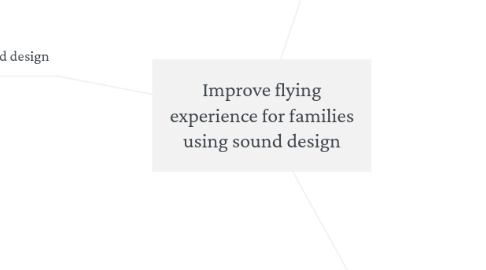
1. sound design
1.1. For what?
1.1.1. Tackle aircraft noise
1.1.1.1. From the plane source: NASA Technologies in 2018(Video)
1.1.1.1.1. Landing Gear Noise Reduction
1.1.1.1.2. landing gear cavity treatments
1.1.1.1.3. Adaptive Compliant Trailing Edge flexible wing flap
1.1.1.2. high-tech headphones
1.1.1.2.1. noise-cancelling headphones
1.1.1.2.2. 4D Sound Headphones
1.1.2. Tackle Airport Noise
1.1.3. make customers more comfortable
1.1.3.1. forget they’re on a plane 35,000 feet in the air & immerse themselves in the relaxing experience
1.1.4. introduce better inflight entertainment equipments
1.1.4.1. Inflight VR
1.1.4.1.1. VR headset
1.1.4.2. 4D Headphone
1.1.4.2.1. use real-time audio processors to model sound in dynamic environments
1.1.4.2.2. consider the characteristics and geometry of the surroundings
1.1.4.2.3. incorporate Haptic feedback based on acoustical intensity
1.1.4.2.4. reverberates deep bass sound in the ear as it would in real life
1.1.5. bring more convenience to passengers while and before on-boarding
1.1.5.1. Smart Phone connect with Airport acoustic Tour Guide
1.1.6. increase family conversation opportunity(to be discovered)
1.1.6.1. earn more private space on the plane
2. Flying trip
2.1. Unpleasant experience on the plane
2.1.1. noisy neighbours, esp. crying baby
2.1.1.1. how to mute noises
2.1.2. crammed space
2.1.2.1. How to stimulate a spacious spectacle for passengers with technology
2.1.3. long and boring flying hours
2.1.4. frustrating amusement flight equipments
2.1.4.1. how to update amusement equipments
2.1.5. hard to call crews during busy time
2.1.6. feel awkward to call the flight attendant
2.1.6.1. How to improve Bell Service without making passengers awkward and bothering others
2.1.7. awful meals
2.1.8. anxiety for security
2.1.9. concern for health:
2.1.9.1. sleep disturbance
2.1.9.2. hearing impairment
2.1.9.3. heart disease
2.1.9.3.1. How to promote healthy lifestyle on the air
2.1.9.4. sedentary state
2.1.10. encounter a technical problem of the flight seat screen
2.1.11. unable to sit next to your partner
2.1.12. jet lag
2.1.12.1. how to minimise jet lag
2.1.13. limited activities, eg. unable to cigarette
2.2. Passengers' activities
2.2.1. activities before boarding
2.2.1.1. arrival at the airport, reach the terminal
2.2.1.2. wait in line for security check, on boarding(long &stressful)
2.2.1.2.1. bear airport noises
2.2.1.3. shopping in airport stores
2.2.1.3.1. limited shopping time, unfamiliar shop arrangements
2.2.1.4. eat a meal or drink a coffee
2.2.1.5. communicate with families
2.2.1.6. check phone
2.2.1.7. read
2.2.2. activities on the plane
2.2.2.1. eat
2.2.2.2. read
2.2.2.3. sleep
2.2.2.3.1. How to improve sleep quality for passengers on air
2.2.2.4. watch movies
2.2.2.4.1. How to make audience feel more in the cinema
2.2.2.4.2. Blind people: cannot profit the amusement function
2.2.2.5. work
2.2.2.6. check map with flight information
2.2.2.6.1. How to provide more useful information before passengers leave the plane
3. family outing
3.1. who
3.1.1. parents with children
3.1.1.1. hope children be quiet but happy
3.1.1.1.1. Pain point
3.1.1.2. seek for more family interaction but not bother others
3.1.2. young couples
3.1.2.1. seek for romance but not bother others
3.1.2.1.1. Pain point
3.1.3. old couples
3.1.3.1. seek for quietness
3.2. why
3.2.1. on vacation
3.2.1.1. time spent on airplane is part of journey
3.2.2. return home for family reunion(Eg. Christmas)
